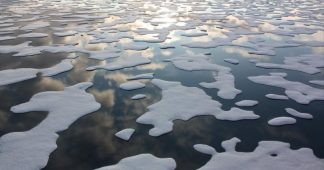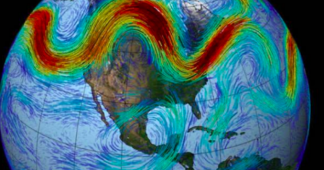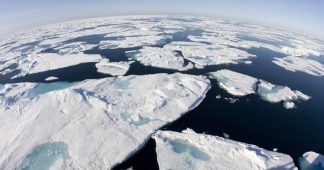Crustaceans in the Mariana Trench and other underwater canyons feed on food from the surface laced with carbon-14 from Cold War bomb tests
o place on Earth is free from human influence—not even the bottom of the deepest trenches in the ocean.
Shrimp-like critters from three West Pacific ocean trenches were found to munch on food that sinks down from the surface, leaving a unique chemical signature from decades-old nuclear bomb tests in the bodies of the deep-sea crustaceans. The findings, published recently in Geophysical Research Letters, not only help marine scientists figure out how these bottom dwellers survive, but also underscore the depths to which humanity’s influence can penetrate.
Deep ocean trenches may be among the least explored nooks on Earth. The deepest of these, the Mariana Trench in the Pacific Ocean, reaches down to about 36,000 feet below sea-level. (Mt. Everest could sit at the bottom, and its summit would still lie beneath more than a mile of water.) At the bottom, temperatures hover just above freezing and the water exerts a pressure more than 1,000 times that felt at the surface.
“Biologically, [ocean] trenches are taken to be the most pristine habitats on Earth,” says Weidong Sun, a geochemist at the Institute of Oceanology in China and coauthor of the new study. “We are interested in how life survives down there, what’s its food source, and whether human activities have any influence.”
/https://public-media.si-cdn.com/filer/72/19/721939e7-1e7c-44fa-b556-8c66a3703525/gettyimages-629464239.jpg)
In those dark depths, one of the most common critters is the shrimp-like amphipod, a family of crustaceans that scavenge the ocean floor for food. Where that food comes from is a matter of debate. Potential sources include morsels that percolate up from Earth’s interior, nutrient-rich sediment that slides down steep trench walls, or tasty detritus that wafts down from the surface.
A recent haul of deep-sea amphipods offered Sun and colleagues a chance to solve this marine mystery. Using baited traps, two Chinese research vessels in 2017 harvested amphipods from three trenches in the West Pacific, including the famous Mariana Trench. Sun’s team chemically analyzed the amphipods’ muscle tissue and gut contents and found elevated levels of carbon-14, a heavy variant of carbon. The levels closely matched abundances found near the surface of the ocean, where the amount of carbon-14 is higher than usual thanks to nuclear bomb tests conducted more than half a century ago.
Carbon comes in a few different varieties based on how many neutrons are stuffed into its atomic nucleus. About one out of every trillion carbon atoms on Earth has two extra neutrons. This form, known as carbon-14, occurs naturally thanks to high-speed atomic particles from deep space whacking into nitrogen atoms. But in the middle of the 20th century, humans doubled the amount of carbon-14 in the atmosphere.
According to the International Atomic Energy Agency, from 1945 to 1963 the United States and the Soviet Union (with a little help from the United Kingdom and France) detonated nearly 500 nuclear bombs, 379 of which exploded in the atmosphere. These tests dramatically increased the amount of carbon-14 on our planet. The Test Ban Treaty of 1963 put a stop to most atmospheric and underwater tests, and carbon-14 levels in the atmosphere started a slow return to normal—though they are still higher than pre-nuclear levels—as ocean waters and land-based life absorbed carbon from the air.
This steady decline of carbon-14, which has a half-life of about 5,730 years, has become a useful tool for figuring out the age and source of organic matter. Throughout any organism’s life, it latches on to carbon in the environment. When the organism dies, that exchange stops. By measuring how much carbon is in the form of carbon-14, researchers can determine when an organism died.
Different places on Earth also have highly variable inventories of carbon-14. Organic material from inside the planet is largely free of carbon-14. Sediments from ocean trench walls also have very low levels. But material from the ocean surface mirrors the relatively high amounts in the atmosphere.
In the muscle tissue of the harvested amphipods, carbon-14 levels closely matched surface abundances from 2004 to 2007, which suggests that these creatures live for more than a decade. Their cousins near the surface typically live for just two years. The freshly digested food in the amphipods’ guts, meanwhile, had carbon-14 levels similar to those found in contemporary surface samples, suggesting that surface flotsam quickly plummets to the deepest trenches where the amphipods scarf it down.

While the nuclear bomb signature has been recorded a couple miles down in the West Atlantic, no one has seen it as these depths before. “This is just interesting as all get out,” says Robert Key, a Princeton oceanographer who was not involved with this study. He points out that starting about a mile below the surface of the North Pacific, carbon-14 levels closely match what the atmosphere looked like before the bomb tests. “The high carbon-14 [in the amphipods] could only come from food that’s come down from the top,” he says.
The abundance of material created in nuclear bomb tests high in the sky found in the bodies of deep-dwelling amphipods underscores a very intimate connection between human activity and the most isolated reaches of the sea.
“These are indeed extraordinary results, but I am not surprised,” says Timothy Shank, a researcher at the Woods Hole Oceanographic Institution. “From 25 years of conducting exploration and research on deep-sea ecosystems, I find their connection to us being closer than we ever thought.” Toilets and showers lurk two miles down, he says, while plastic and metal trash has turned up in more than 30 deep-water canyons off the east coast of the United States.
And this isn’t the first time that researchers have seen trench amphipods dealing with humanity’s refuse. A 2017 paper in Nature Ecology & Evolution reported that amphipods from two West Pacific trenches contained elevated levels of the industrial pollutants PCB, once widely used in electronic devices, and PBDE, a flame retardant. In some Mariana Trench amphipods, PCB levels were as much as 50 times higher than levels found in crabs caught near the Liaohe River, one of the most polluted rivers in China.
Sun and colleagues aren’t done with their amphipods or the rich ecosystem that flourishes in these underwater canyons. “There are lots of creatures in the very deep, very dark places,” Sun says. “We want to understand how the ecosystem deals with human activity … and how the system reacts to this heavy pollution from the surface.”











